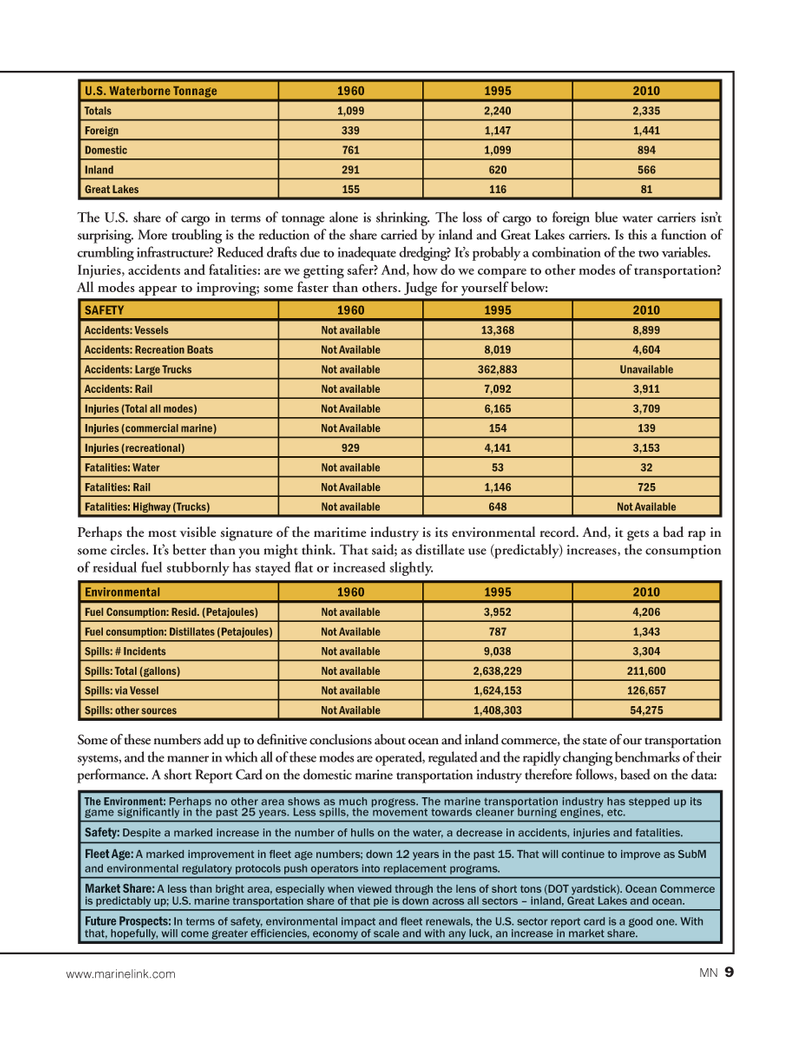
Page 9: of Marine News Magazine (February 2013)
Bulk Transport Leadership Roundtable
Read this page in Pdf, Flash or Html5 edition of February 2013 Marine News Magazine
The U.S. share of cargo in terms of tonnage alone is shrinking. The loss of cargo to foreign blue water carriers isn?t surprising. More troubling is the reduction of the share carried by inland and Great Lakes carriers. Is this a function of crumbling infrastructure? Reduced drafts due to inadequate dredging? It?s probably a combination of the two variables. Injuries, accidents and fatalities: are we getting safer? And, how do we compare to other modes of transportation? All modes appear to improving; some faster than others. Judge for yourself below: Perhaps the most visible signature of the maritime industry is its environmental record. And, it gets a bad rap in some circles. It?s better than you might think. That said; as distillate use (predictably) increases, the consumption of residual fuel stubbornly has stayed at or increased slightly. Some of these numbers add up to de nitive conclusions about ocean and inland commerce, the state of our transportation systems, and the manner in which all of these modes are operated, regulated and the rapidly changing benchmarks of their performance. A short Report Card on the domestic marine transportation industry therefore follows, based on the data: U.S. Waterborne Tonnage 1960 1995 2010 Totals 1,099 2,240 2,335Foreign3391,147 1,441 Domestic761 1,099 894Inland291 620566Great Lakes 155 116 81 The Environment: Perhaps no other area shows as much progress. The marine transportation industry has stepped up its game signiÞ cantly in the past 25 years. Less spills, the movement towards cleaner burning engines, etc. Safety: Despite a marked increase in the number of hulls on the water, a decrease in accidents, injuries and fatalities. Fleet Age: A marked improvement in ß eet age numbers; down 12 years in the past 15. That will continue to improve as SubM and environmental regulatory protocols push operators into replacement programs. Market Share: A less than bright area, especially when viewed through the lens of short tons (DOT yardstick). Ocean Commerce is predictably up; U.S. marine transportation share of that pie is down across all sectors ? inland, Great Lakes and ocean. Future Prospects: In terms of safety, environmental impact and ß eet renewals, the U.S. sector report card is a good one. With that, hopefully, will come greater ef Þ ciencies, economy of scale and with any luck, an increase in market share. Environmental 1960 1995 2010 Fuel Consumption: Resid. (Petajoules) Not available 3,9524,206Fuel consumption: Distillates (Petajoules) Not Available 787 1,343 Spills: # IncidentsNot available 9,0383,304 Spills: Total (gallons) Not available 2,638,229211,600 Spills: via Vessel Not available 1,624,153 126,657 Spills: other sources Not Available 1,408,303 54,275 SAFETY 1960 1995 2010 Accidents: Vessels Not available 13,3688,899Accidents: Recreation Boats Not Available 8,019 4,604 Accidents: Large Trucks Not available 362,883Unavailable Accidents: RailNot available 7,0923,911 Injuries (Total all modes) Not Available 6,165 3,709Injuries (commercial marine) Not Available 154 139Injuries (recreational)9294,141 3,153 Fatalities: Water Not available 5332Fatalities: Rail Not Available 1,146 725Fatalities: Highway (Trucks) Not available 648 Not Available MN 9www.marinelink.com MN Feb2013 Layout 1-17.indd 9MN Feb2013 Layout 1-17.indd 91/30/2013 4:51:47 PM1/30/2013 4:51:47 PM

 8
8

 10
10
